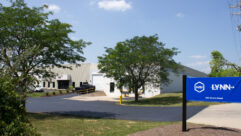

Building a New Market
It’s long been discussed: How can AV integrators extend their control systems expertise to entire buildings? These days, some firms are doing just that.
On the surface, it seems like a natural progression. AV integrators are increasingly handling the lighting and shades in conference rooms and other venues, so why not take things a step further and expand into a building’s mechanical systems, such as HVAC, in order to offer clients a comprehensive package designed to reduce their energy consumption? After all, plenty of enterprises, government agencies, and other client types are already going green, so the addressable market is there for the taking, right? Plus, AV integrators have experience in knitting together disparate systems (think digital signage on a client’s IT network), which makes building integration more of a comfortable evolution than a stretch–in theory.
“In many instances, the electrical contractor had little to no knowledge of those systems, so we were ending up programming the systems and doing a lot of the value-added work anyway,” says Byron Tarry, general manager for system design and integration at AVW-TELAV, a Canadian AV integrator. “Why wouldn’t we just sell some of this stuff and get the revenue from selling the hardware? We’re already doing half of the work.”
Other AV pros agree. As the argument goes, someone is going to become the go-to expert for giving clients what they want, namely an integrated building-management system that connects all the mechanical functions and the AV systems. It might as well be the AV professional.
“What the forward-looking companies are seeing is that there’s a big opportunity to be way more than the building AV experts,” says Scott Walker, president and CEO of Waveguide Consulting, an AV design firm based in Atlanta.
In reality, the market opportunity and what AV integrators bring to the table are far less clear-cut. Suppose an AV integrator proposes configuring a company’s meeting rooms so that the HVAC automatically turns on and off based on when the room-scheduling software says it’s in use. Maybe such a solution includes automatically adjusting the room’s temperature based on the number of people who have confirmed that they’ll attend a meeting there. But pulling off that level of integration requires access to the building’s HVAC system, and therefore one obvious challenge is gaining that access–especially if the client’s facilities team is as skittish as some IT departments are about letting outsiders tap into their system. (The threat isn’t an academic one, either: Hackers have successfully attacked commercial HVAC systems many times.)
Supposing the AV integrator gets access to the HVAC system, the next significant challenge is understanding the interface protocols—including vendor-specific flavors—that HVAC and other building systems use to communicate. One way to find out—and it’s something that organizations such as the Secure Computing Group are hashing out—is for companies to post all the information for a building’s mechanical, electrical, and AV systems to the electronic equivalent of a bulletinboard (protected from hackers, of course).
“It could be messages about status,” says Joe Andrulis, vice president of marketing at AMX. Something like, “‘The building has decided that we are in energy-management mode. If anybody thinks that’s useful, then consume that [information].’ Then you don’t need to define any deeper level of integration to do some pretty amazing things.”Such a scenario would free AV pros from having to learn about the nuances of, say, a Honeywell or Siemens platform. And the arm’s-length design could allay client concerns about giving third parties extensive control over their systems. “That’s the kind of concept that’s going to get us out of the box,” Andrulis says. “We don’t have to integrate with other systems. We just need to be able to see a presentation of the services they provide and then access those services if they’re meaningful to the AV experience.”
Building a New Market
It’s long been discussed: How can AV integrators extend their control systems expertise to entire buildings? These days, some firms are doing just that.
BONE UP ON THE BASICS
Still, this simple communication challenge highlights why building integration isn’t a market that AV pros can simply parachute into and assume that success will follow. Instead, success depends on learning about, and keeping up with, companies and technologies that historically have been outside of AV.
“Stay tuned to the trends of the market,” says Manuel Marichal, senior architect at Leo A Daly, one of the country’s largest architecture, engineering, and interior design firms. “For example, the BACnet [interface protocol] is in, and LonWorks is out.” (BACnet and LonWorks are two leading communications languages for building systems.)
Marichal and others caution that although vendors such as Honeywell and Siemens are major players in HVAC and other building systems, it’s equally important to track smaller players. “The big vendors move too slowly to adopt the latest IT software and applications, and their interfaces are not as customizable as users are looking for,” Marichal says. “It means that smaller companies are developing building-management-system platforms with open protocols, taking the building-automation industry to a new level of interoperability.”
In many cases, it’s another type of access that determines whether an AV integrator can get building-integration jobs: access to the architect, if it’s new construction or a major remodel; or access to a top-level executive with the client, who’s willing to put the integrator on equal footing with its other contractors.
“The conversation with the sustainability officer or the person in that role in the C suite is the earliest and most important conversation to have,” says Howard Nunes, president and CEO of PepperDash Technology Corp., a Boston company that specializes in AV control programming. “Whoever owns that relationship, or has the best opportunity to get at that relationship, is going to win this battle. Most AV folks seem to have a relationship in the company that’s relatively far down the food chain. They’re dealing with a facility manager or a project manager. By the time they get into the conversation, even if they’re early on, a lot of the inspirational decisions have been made–sometimes in the right direction, sometimes not.”
GRANTED AUTHORITY
In the ideal scenario, two things happen: First, the AV integrator comes into the project when the facility is still on the drawing board. Second, the client, the architect, or someone else gives the integrator some level of authority to coordinate the necessary systems and achieve the building-integration goals. At that point, an AV integrator becomes what’s often referred to as the integrated building technology project manager.
“The integrated building technology project manager is someone who has the authority and mandate to drive all of those different consultants and trades,” says AVW-TELAV’s Tarry.
Some AV pros say that it’s not uncommon for others on the project team to balk at the prospect of an integrator guiding their work. “Once you’re telling the architect what kind of shades [to put] on what side of the building, you’re in a different set of britches than simply saying, ‘I want to expand into digital signage,'” says Waveguide’s Walker, who chairs InfoComm’s AV Sustainability Task Force.
Many integrators and vendors say that although there’s a growing market for building integration–particularly when it’s to reduce energy consumption–projects often don’t have someone leading that effort. That leadership vacuum is a problem when it means that the goals aren’t met, but it’s also an opportunity for AV integrators to position themselves as integrated building project managers.
“There has to be somebody on the team that owns the ball to integrate all of these systems together,” says David Wilts, director of integrated building technology at Crestron Electronics. “If it’s all in different silos–mechanical, electrical, lighting, AV, low-voltage, fire–there’s nobody on the design team whose job it is to make sure that all of these systems talk to one another. They may all share the same IT network, but none of these systems are sharing any data.”
Crestron has made the ability to integrate building systems with its AV control systems a significant part of its latest Core 3 control platform. The system uses standard TCP/IP to communicate, which allows, for instance, touch panels to talk to HVAC systems using BACnet over IP (see “5-Minute Interview” with Crestron’s Fred Bargetzi, September/October 2010).
“AV has done an excellent job of making complex systems easy to use,” Wilts says. “We see a huge opportunity to empower the building manager with a user interface that can bring all of this together.”
But great technology can’t completely replace good coordination. For example, if a lighting designer specifies a certain control system but doesn’t provide additional details, such as the desired scenes and the relative brightness for each lighting circuit in those scenes, that lack of information leaves the AV integrator and other contractors to chase down the answers or make educated guesses. Either way, the final solution may not deliver the integration and energy savings that the client had hoped for.
The solution? “You could have a programmer involved in the design process taking in all of these requirements,” Walker says. “Then when it goes to the construction phase, there’s already somebody who understands how everything is supposed to work and can bridge the gap between the design team and the construction team.”
Walker also encourages design teams to create a “design brief” that summarizes how all of the systems should work together. That way, when the electrical contractor is putting in the lighting-control systems, he or she knows exactly what the scenes should be and how the infrastructure should support them, making it easier to coordinate an integrated system.
Of course, yet another option is for the AV integrator to install the lighting. “If they say, ‘Why don’t we put in the lighting controls, and then we’ll handle all of the programming ourselves and the integration of these systems,’ it makes it easier on the whole design team and can simplify the construction process,” Wilts says.
Building a New Market
It’s long been discussed: How can AV integrators extend their control systems expertise to entire buildings? These days, some firms are doing just that.
ROLE-PLAYING
And that’s where the push for integrated building management gets especially dicey–even as it’s acknowledged that the AV integrator’s role should expand, other trades are eyeing the same opportunity. In some respects, building integration today is like the intersection of AV and IT a few years ago: There’s lots of optimism about new revenue opportunities, but also lots of fretting that outsiders could just as easily claim more work for themselves.
Convening Efficiency: Vancouver Convention Centre
Credit: Dave Roels
At four city blocks, the Vancouver Convention Centre’s size suggests an equally big utility bill. Canadian integrator AVW-TELAV recently completed a major project that improves the facility’s energy efficiency by linking its AV, lighting, and HVAC systems.
“It’s probably the most advanced scenario that we’ve done,” says Byron Tarry, AVW-TELAV’s general manager for system design and integration. “We replaced a 25-year-old lighting system with a quarter-million dollars’ worth of Creston lighting.”
AVW-TELAV also connected the convention center’s room-scheduling platform to Crestron’s RoomView Server Edition. This setup works with motion sensors to, for example, identify a room where a meeting has been cancelled and then shut off the lighting, AV, and HVAC. It also helps set up rooms before events.
In the center’s east building, AVW-TELAV worked with the facility’s engineering staff and outside consultants to develop a custom interface between the Creston control system and the building’s HVAC system. This proved challenging in part because the east building is leased space and the convention center staff don’t enjoy control over the building systems—an example of the types of hurdles that AV pros will have to overcome to be successful in building integration, Tarry suggests.
In the convention center’s new west building, AVW-TELAV installed 60 Crestron touchscreens that control AV, lighting, and HVAC in meeting rooms and other spaces. In both the east and west buildings, AVW-TELAV also installed Crestron GLS-ODT-C-2000 occupancy sensors, which control 40 amplifiers. Shutting those off immediately after a room empties will save an estimated 23,000 kilowatt-hours annually, not counting the savings on reduced cooling. As impressive as those kinds of bottom-line metrics might be, AVW-TELAV believes that they’re also just a first step.
“It’s one thing to create efficiency,” Tarry says. “It’s another to then track and monitor it and evaluate the success. That’s where we’ve got some ways to go in terms of proving the business case.”
So far, the results have been good enough that the Canada Green Building Council gave the west building a LEED Platinum certification for new construction. That makes it the world’s first convention center to achieve LEED’s highest designation—and should help AVW-TELAV win similar projects in its hometown, where new commercial buildings are held to a high LEED standard.
“Vancouver is one of the first cities to mandate commercial buildings built in the city to be built to LEED Gold or higher,” Tarry says.
“The HVAC guys could easily pick this up if they cared to,” says PepperDash’s Nunes. “The lighting people do care to and they’re actually moving in this direction.”
To capitalize on the AV-IT convergence, AV integrators had to get serious about offering the right mix of services, including adding staff that understood what firewalls were, for instance, and how to get videoconferencing and signage to play nicely with them. Similarly, success in building integration requires significant investments in order to build credibility in the eyes of potential clients.
“You can’t be reluctantly involved in building-management systems,” says AMX’s Andrulis. “You’re either in or you’re not. You’ve got to be willing and able to go toe-to-toe with the traditional players.”
Some AV pros with experience in building integration say that the sales process has to change, with a focus on return-on-investment and how the project will meet the client’s financial goals. “The sales proposition is very different from AV, which in many instances was more an ego spend in the higher-end rooms or just focused on a whole different set of priorities,” says AVW-TELAV’s Tarry.
For example, at the Masdar Headquarters building in the United Arab Emirates, Crestron’s Wilts got an AV budget not in dollars, but in watts: 8W per square meter, maximum. The building, which was designed by Adrian Smith + Gordon Gill Architecture of Chicago, is meant to be “energy positive” in that it will generate more energy than it consumes. It’s part of what Masdar City promoters say will be “the world’s first carbon-neutral city.”
Tarry’s building-integration projects at AVW-TELAV haven’t included a watts budget, but the change doesn’t surprise him. Forces bigger than individual building operators are often the largest drivers of integrated buildings. “I could see that concept starting to push into city code requirements,” Tarry says of energy budgets. Recently, AVW-TELAV integrated the convention center in Vancouver, Canada. Vancouver is one of the first cities to mandate that commercial buildings be built to LEED Gold or higher standards (see “Convening Efficiency”).
It’s no secret that the U.S. Green Building Council’s Leadership in Energy & Environmental Design (LEED) standards play a big role in today’s commercial construction, and ultimately toward integrated building-management systems. If most AV firms are able to take just one step toward offering broader building-integration services, it would be to identify one or more staffers to earn LEED Accredited Professional credentials.
Walker argues that the potential payoff is compelling enough: “The opportunity is 10 times what the AV opportunity is.”










